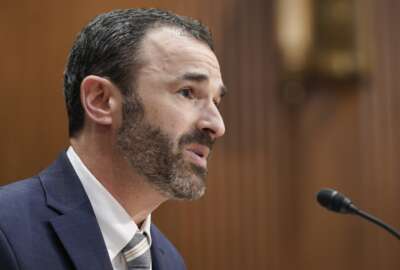OPM calls for stronger focus on federal HR in new legislative proposal
In an effort to close a governmentwide skills gap, OPM sent a legislative proposal to Congress requesting statutory authority for all federal HR employees.
Editor’s Note: This story was updated to clarify that the legislative proposal would codify the already-existing Federal HR Institute. A previous version of the story incorrectly stated that the proposal would newly create a Federal HR Institute.
As agencies work on innovations in their federal hiring and retention strategies, the Office of Personnel Management is taking steps to try to better support the employees working behind the scenes on those efforts.
In a legislative proposal sent to Congress last week, OPM requested statutory authority over the nearly 40,000 federal employees working in human resources positions governmentwide. If enacted, OPM’s proposal would amend Title 5, giving OPM the ability to manage training and development of the HR workforce across all agencies.
“Although there has been strong interest in governmentwide efforts to mitigate skills gaps in technology positions and cybersecurity, acquisitions and other mission critical occupations, HR professionals have not received the same level of focus and prioritization, even though they are critical for assisting in the hiring and retention strategies for the entirety of the federal workforce,” OPM wrote in a draft of the legislative proposal, shared with Federal News Network.
In practice, having statutory authority would enable OPM to develop governmentwide HR training programs and create clearer HR career paths, while also managing the budget and resources to support those efforts.
“It is critical that we ensure that we’ve got world-class HR professionals available in the federal government, trained to support our world-class workforce, so that they all can deliver for the American people,” OPM Acting Director Rob Shriver said during a Dec. 10 Chief Human Capital Officers Council meeting.
The proposal to Congress detailed various recommendations for improving the recruitment, retention and engagement of federal HR staff. For instance, the proposal would codify the Federal Human Resources Institute — a training institute at OPM that centrally manages HR career development and training opportunities across government. The proposal would also establish an HR training fund to support the institute.
During the first three years of the program, OPM would also submit annual reports to Congress detailing the budgeting, major initiatives, expenses and metrics for the program.
“To strengthen the capacity and capabilities of the federal human resources workforce, OPM requires the statutory authority, leadership and funding to provide strategic workforce planning, training and development activities across agencies,” OPM said.
Persistent skills gaps in federal HR, OPM says
The need for better support of the federal HR workforce has been widely documented. In 2022, OPM named HR as a top mission-critical skills gap across agencies. The presence of a governmentwide HR skills gap means many agencies struggle to build important skills in their HR workforce, or even fill HR positions in the first place. The Government Accountability Office has also kept strategic human capital management on its high-list risk for more than 20 years.
“Although the need to improve strategic human capital management has been cited repeatedly by GAO as a high risk to federal operations, to date, federal HR workforce development has not received prioritization and resourcing commensurate with their critical value to hire, retain, develop and engage a high-quality workforce for the rest of government,” OPM wrote earlier this year in its fiscal 2025 congressional budget justification.
In the legislative proposal, OPM also pointed to what it said is a “stark” example of the governmentwide HR skills gap. Notably, agencies have reported a 45% failure rate of HR specialists who take a certification assessment to be able to conduct hiring processes.
The retention rate of HR specialists is also lower than the governmentwide average. In general, agencies have a two-year retention rate of about 73%, but the retention rate for HR specialists is 70%. Even lower, just 60% of HR assistants stay in their jobs for at least two years. And when surveyed, one in four HR employees have said they plan to leave their positions for a different federal job, OPM noted.
But in one recent development, OPM onboarded a senior leader who’s focused specifically on supporting the governmentwide HR workforce. Jeff Bardwell, OPM’s new senior advisor for the HR workforce, is the first person ever to hold the career federal position.
“I’m sensing a lot of excitement that my role is finally established and filled, because I think everyone wants to better support and empower our federal HR workforce,” Bardwell said during the Dec. 10 CHCO Council meeting.
Bardwell has been in the role for just about three weeks, but the legislative proposal seeks to codify the HR leadership job and make it a permanent position for years to come.
Using acquisition workforce changes as blueprint
The legislative proposal on the HR workforce is not a new concept — it’s modeled after a similar proposal for the acquisition workforce from several years ago. The prior acquisition workforce proposal also came after recruitment challenges and a persistent skills gap in the area.
OPM said the acquisition workforce proposal created a “successful precedent” that addressed skills gaps in that sector of the federal workforce. The language of the new proposal on the HR workforce is modeled after the changes Congress previously granted for the Office of Federal Procurement Policy and the Federal Acquisition Institute — a training institute for the federal contracting workforce — as well as an acquisition workforce training fund.
The acquisition proposal also similarly created a leadership position called the associate administrator for acquisition workforce programs. Joanie Newhart currently serves in that role at the Office of Management and Budget.
During the CHCO Council meeting, OPM’s Bardwell said he sees plenty of similarities between the two segments of the federal workforce — HR and acquisition.
“The two professions are two sides of the same coin,” Bardwell said. “Both are OPM-designated mission-critical occupations, both are layered with myriad laws, policies [and] procedures … Both acquisition and human resources are very challenging professions that require very highly skilled professionals to deliver the results that our stakeholders demand.”
But at the same time, Bardwell noted that qualified, skilled professionals in HR and acquisition “don’t grow on trees.”
“They have to be cultivated — and cultivating highly skilled professionals requires clear entry pathways, structured training regimens and robust developmental opportunities,” Bardwell said.
Other OPM efforts to support federal HR
Aside from last week’s legislative proposal, human capital leaders are working on additional efforts to support the federal HR workforce.
“We know that our HR professionals are often the first people to interact with candidates for federal employment, the first people to welcome new employees, and help them develop new skills and competencies,” Shriver said. “HR also helps supervisors manage performance and work to ensure employees stay motivated and engaged.”
Earlier this year, for example, OPM updated the HR competency models, covering the nearly 40,000 federal employees in HR across government.
“This model helps us map skill needs to the training and development that we prescribe for our HR practitioners,” Bardwell said.
Additionally, nine agencies are currently involved in a pilot program that’s focused on updating career paths for the federal HR workforce. The pilot incorporates the updated competency models for HR positions and covers the entirety of an HR employee’s career, from entry level to leadership roles.
In collaboration with the CHCO Council, OPM also stood up talent teams that aim to help agencies reach the talent they need. Federal HR professionals also have data dashboards available, where they can view and analyze workforce data for strategic human capital planning.
OPM also plans to soon launch a federal HR “career growth portal,” which will incorporate the new HR career path models and build on the current pilot.
“It takes a knowledgeable and competent HR workforce to recruit, hire, engage and train managers and employees to maximize performance,” Colleen Heller-Stein, executive director of the CHCO Council, said during the council meeting. “Elevating the HR workforce is an important priority for OPM and the CHCO Council both.”
Copyright © 2025 Federal News Network. All rights reserved. This website is not intended for users located within the European Economic Area.
Drew Friedman is a workforce, pay and benefits reporter for Federal News Network.
Follow @dfriedmanWFED






